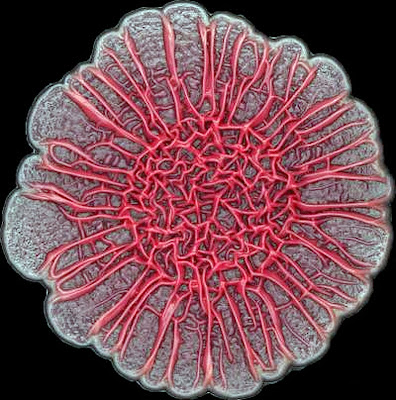Integrated circuit-based electrochemical sensor for spatially resolved detection of redox-active metabolites in biofilms.
New York, NY— A research team led by Ken Shepard, professor of electrical engineering and biomedical engineering at Columbia Engineering, and Lars Dietrich, assistant professor of biological sciences at Columbia University, has demonstrated that integrated circuit technology, the basis of modern computers and communications devices, can be used for a most unusual application—the study of signaling in bacterial colonies.
They have developed a chip based on complementary metal-oxide-semiconductor (CMOS) technology that enables them to electrochemically image the signaling molecules from these colonies spatially and temporally. In effect, they have developed chips that "listen" to bacteria.
"This is an exciting new application for CMOS technology that will provide new insights into how biofilms form," says Shepard. "Disrupting biofilm formation has important implications in public health in reducing infection rates."

Caption: The development of colony biofilms by Pseudomonas aeruginosa is affected by redox-active compounds called phenazines. A phenazine-null mutant forms a hyperwrinkled colony with prominent spokes, while wild-type colonies are more constrained and smooth.
Credit: Hassan Sakhtah, Columbia University. Usage Restrictions: None
The researchers, who include PhD students Dan Bellin (electrical engineering) and Hassan Sakhtah (biology), say that this is the first time integrated circuits have been used for such an application—imaging small molecules electrochemically in a multicellular structure. While optical microscopy techniques remain paramount for studying biological systems (using photons allows for relatively non-invasive interaction to the biological system being studied), they cannot directly detect critical components of physiology, such as primary metabolism and signaling factors.
The team thought there might be a better way to directly detect small molecules through techniques that employ direct transduction to electrons, without using photos as an intermediary. They made an integrated circuit, a chip that, Shepard says, is an "'active' glass slide, a slide that not only forms a solid-support for the bacterial colony but also 'listens' to the bacteria as they talk to each other."
Cells, Dietrich explains, mediate their physiological activities using secreted molecules. The team looked specifically at phenazines, which are secreted metabolites that control gene expression. Their study found that the bacterial colonies produced a phenazine gradient that, they say, is likely to be of physiological significance and contribute to colony morphogenesis.
"This is a big step forward," Dietrich continues. "We describe using this chip to 'listen in' on conversations taking place in biofilms, but we are also proposing to use it to interrupt these conversations and thereby disrupt the biofilm. In addition to the pure science implications of these studies, a potential application of this would be to integrate such chips into medical devices that are common sites of biofilm formation, such as catheters, and then use the chips to limit bacterial colonization."
The next step for the team will be to develop a larger chip that will enable larger colonies to be imaged at higher spatial and temporal resolutions.
"This represents a new and exciting way in which solid-state electronics can be used to study biological systems," Shepard adds. "This is one of the many emerging ways integrated circuit technology is having impact in biotechnology and the life sciences."
###
The study was supported by the National Institutes of Health and the National Science Foundation.
Contact: Holly Evarts holly.evarts@columbia.edu 347-453-7408 Columbia University School of Engineering and Applied Science











3 comments:
Bandar poker Terpercaya
Bandar poker Terpercaya
Bandar poker Terpercaya
Bandar poker Terpercaya
Bandar poker Terpercaya
Bandar poker Terpercaya
Dewacintaqq
Dewacintaqq.com
Dewa cintaqq
Poker Online
Domino 99
BandarQ
link alternatif Dewacintaqq
Daftar Dewacintaqq
Bandar poker Terpercaya
dewacintaqq
dewacintaqq.com
dewa cintaqq
Cinta
daftar dewacintaqq
link alternatif dewacintaqq
Bandar poker Terpercaya
Bandar poker Terpercaya
SITUS TOGEL ONLINE
Situs Togel Hongkong
Situs Togel Singapore
Bandar poker terpercaya
Daftar Dominohalo
Bandar poker terpercaya
Daftar twinpoker88
Bandar poker terpercaya
Daftar Delimapoker
Bandar poker terpercaya
Daftar Papadomino
DewacintaQQ
link alternatif Dewacintaqq
Deposit
Deposit dewacintaqq
Poker Indonesia
Poker Online Indonesia
Bandar QQ
Agen Ceme Online
Daftar Situs Poker
Poker Online Terpercaya
Judi Poker
Poker Online Uang Asli
Poker Uang Asli
Situs Poker Online
Agen Poker
Poker88
Capsa Susun Online
daftar idn poker
idnpoker
bigceme
ceme
ceme online
bandar ceme
idn poker
Idnplay
idn play
poker
poker idn
agen poker online
poker online
situs poker online
judi online
situs judi online
This blog is about Integrated circuit-based electrochemical sensor for spatially resolved detection of redox-active metabolites in biofilms is quite interesting and give you some extra knowledge about electrochemical sensors. Now its time to get lock repairing services from Locksmith Leeds click for more information.
This blog is very informative and also if you wats more information custom boxes with logo wholesale
Post a Comment